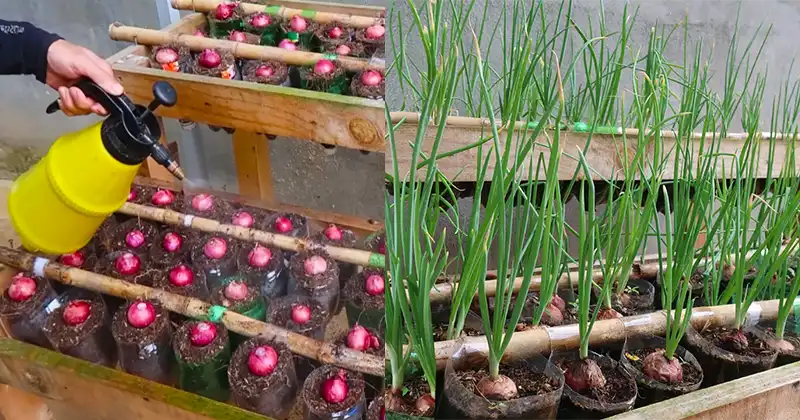Embarking on a journey to grow your own onions is not only a rewarding experience but can also be eco-friendly and resourceful. In this guide, we will explore a simple yet effective method of growing onions in recycled plastic bottles using kitchen waste fertilizer. Additionally, we will delve into the details of creating a nutritious kitchen waste fertilizer to support the growth of your onion garden.
Materials Needed:
- Plastic bottles (half-cut)
- Red onion bulbs
- Compost or potting mix
- Drill or sharp knife
- Kitchen waste (fruit and vegetable scraps)
- Blender or chopping board
- Spray or pulverize bottle
- Watering can or hose
Steps to Grow Onions in Plastic Bottles:
- Prepare the Plastic Bottles:
- Take half-cut plastic bottles and make several drainage holes at the bottom. Adequate drainage is crucial to prevent waterlogging.
- Fill with Compost:
- Fill each plastic bottle with high-quality compost or a well-balanced potting mix. The soil should be loose and well-aerated.
- Prepare Onion Bulbs:
- Cut the top of each red onion, leaving a small portion intact. This encourages new growth from the center of the onion.
- Plant the Onions:
- Place one prepared red onion bulb in each plastic bottle, ensuring that the cut top is facing upward. Press the onion gently into the soil.
- Make Kitchen Waste Fertilizer:
- Collect kitchen waste such as fruit and vegetable scraps, coffee grounds, and eggshells. Avoid using meat or dairy products, as they may attract pests.
- Chop or blend the kitchen waste into small pieces for efficient decomposition.
- Place the processed kitchen waste in a container and add water to cover the scraps. Let this mixture ferment for a few days, stirring occasionally.
- Strain and Dilute the Fertilizer:
- After fermentation, strain the kitchen waste mixture to obtain a liquid fertilizer.
- Dilute the liquid fertilizer with water in a 1:3 ratio (one part fertilizer to three parts water). This ensures that the fertilizer is not too concentrated.
- Apply Kitchen Waste Fertilizer:
- Transfer the diluted kitchen waste fertilizer into a spray or pulverize bottle.
- Apply the fertilizer to the soil around the onion plants. This should be done every two weeks to provide a consistent source of nutrients.
- Watering:
- Maintain the soil’s moisture by watering the onions regularly. Avoid overwatering, as this can lead to root rot.
- Sunlight and Care:
- Place the plastic bottles in a location that receives ample sunlight, ideally 6-8 hours per day.
- Monitor the growth of the onions, and remove any weeds to prevent competition for nutrients.
- Harvesting:
- Harvest the onions when the green tops start to yellow and fall over. Gently pull the onions from the soil and allow them to dry before storage.
Conclusion:
Growing onions in plastic bottles with kitchen waste fertilizer is a straightforward and sustainable method that allows you to repurpose materials and reduce kitchen waste. By following these detailed steps, you can cultivate healthy, homegrown onions while contributing to a more eco-friendly lifestyle. Experiment with different kitchen waste combinations to find the best fertilizer mix for your onion garden. Happy gardening!
